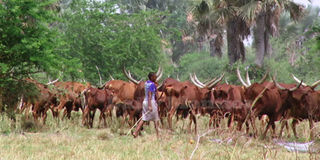Govt quarantines Ntoroko over foot and mouth disease

A girl grazes animals in Rwebisengo Sub-county, Ntoroko District, last week. PHOTO/ALEX ASHABA
What you need to know:
- Under the quarantine, authorities don’t allow any movement of animals, sale of milk and all markets have been closed.
Government has imposed a quarantine on the movement of animals and their products in Ntoroko District following an outbreak of foot and mouth disease. The outbreak has been attributed to an influx of cattle from DR Congo.
The Ntoroko District production officer, Dr Patrick Businge Bagonza, said the refugees sneaked into the country with sick animals through the porous borders in May and June.
Dr Businge said they first recorded 200 cases of foot and mouth disease, but the number has increased to 4,000. They have now decided to impose the quarantine.
“The refugees who came with animals brought the disease. Most people’s farms have now registered cases. The most affected sub-counties are Bweramule, Rwebisengo, and Kibuuku,” he said.
He said under the quarantine, they don’t allow any movement of animals, transportation of milk products and all markets have been closed.
Dr Businge said they have written to the Ministry of Agriculture, Animal Industry and Fisheries (MAAIF) about the farmers plight.
“Our efforts to get a vaccine from MAAIF is yet to yield fruits, we are now waiting,” Dr Businge said.
The indigenous cattle keepers in Ntoroko are competing for pasture and water with DR Congo refugees.
The refugees entered the country with more than 5,000 herd.
Ntoroko is among the districts in western Uganda found in the cattle corridor and their main economic activity is cattle keeping and fishing.
The cattle keepers said imposing quarantine during lockdown will greatly affect their livelihood.
Mr Christopher Adyeba, from Rwebisengo, said many cattle keepers who have registered cases of foot and mouth disease are now complying with quarantine measures.
About foot and mouth disease
Foot and mouth disease sometimes referred to as hoof and mouth disease is an infectious and fatal viral disease that affects cloven-hoofed animals, including domestic and wild bovid.
In the early stage, the disease manifests itself among cows through a rise in temperature and the animal becomes dull.
A milking cow will show a sudden drop in yield. Blisters begin to develop, usually within a few hours, most frequently on the upper surface of the tongue and the bulbs of the heels. Feeding and cuddling may cease and the animal is ‘tucked up’ with staring coat.



